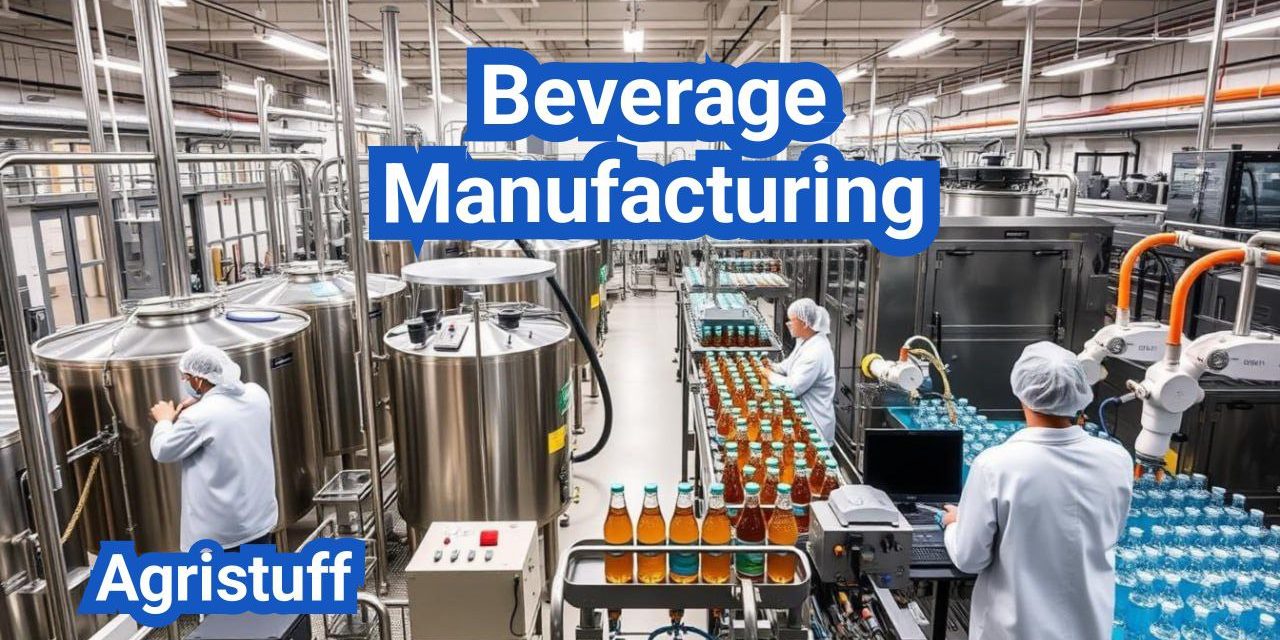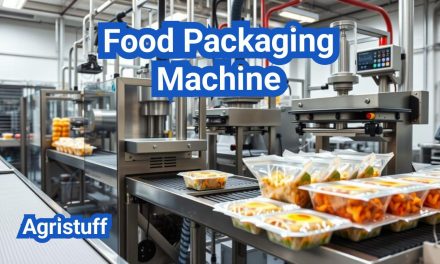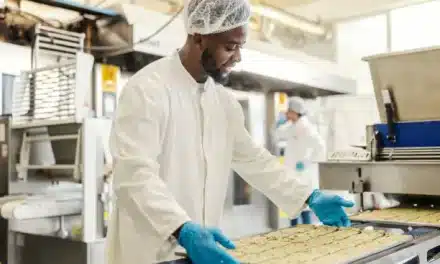The process of beverage manufacturing involves several critical stages, including formulation, mixing, filling, and packaging. In the United States, the industry relies heavily on advanced technologies to ensure quality and safety.
Syrup rooms play a vital role in preparing the beverage formula, while carbonation adds CO2 to the drink. Aseptic filling is another crucial step, involving the filling of containers in a sterile environment to prevent contamination.
Key Takeaways
- Understanding the stages involved in beverage production is crucial for quality and safety.
- Syrup rooms are essential for preparing the beverage formula.
- Carbonation adds CO2 to the drink, enhancing its taste and texture.
- Aseptic filling ensures the product remains sterile and contamination-free.
- The U.S. beverage manufacturing industry relies on advanced technologies.
The Beverage Manufacturing Industry in the United States
With a large market size and steady growth trends, the U.S. beverage manufacturing industry is a notable economic contributor. The industry encompasses a wide range of beverages, from soft drinks and juices to bottled water and energy drinks.
Current Market Size and Growth Trends
The U.S. beverage manufacturing industry has experienced significant growth over the years, driven by consumer demand for diverse beverage options. According to industry reports, the market size has been expanding steadily, with an annual growth rate that reflects the industry’s resilience and adaptability.
Key factors contributing to this growth include:
- Increasing consumer preference for premium and health-oriented beverages
- Expansion of distribution channels, including e-commerce and convenience stores
- Innovative marketing strategies and product launches by major players
Major Players and Market Share
The U.S. beverage manufacturing industry is dominated by a few large companies, including Coca-Cola and PepsiCo, which have significant market share. These companies have a strong presence across various beverage categories and invest heavily in marketing and product development.
“The beverage industry is highly competitive, with companies constantly innovating to stay ahead of consumer trends.” –
Industry Expert
NAICS and SIC Codes for Beverage Manufacturing
Beverage manufacturing is classified under specific NAICS (North American Industry Classification System) and SIC (Standard Industrial Classification) codes. The relevant NAICS code for beverage manufacturing is 3121, which covers soft drinks, juices, and other beverages.
| Code Type | Code | Description |
|---|---|---|
| NAICS | 3121 | Beverage Manufacturing |
| SIC | 2086 | Bottled and Canned Soft Drinks |
Beverage Manufacturing Process Overview

Understanding the beverage manufacturing process is crucial for producers aiming to deliver consistent, high-quality beverages. This process involves several key stages that transform raw ingredients into finished products ready for consumption.
Production Stages from Formulation to Distribution
The production of beverages encompasses several critical stages:
- Formulation: Developing the recipe and ensuring the ingredients meet quality standards.
- Mixing: Combining ingredients according to the formulation.
- Filling: Filling containers with the beverage.
- Packaging: Preparing the filled containers for distribution.
- Distribution: Delivering the final product to retailers and consumers.
Process Flow Chart Explanation
A process flow chart is a visual representation of the steps involved in the beverage manufacturing process. It helps in understanding the sequence of operations, from raw material input to the final product output. The chart typically includes:
- Raw material intake and storage.
- Formulation and mixing.
- Filling and packaging.
- Quality control checks.
- Packaging and labeling.
- Final product storage and distribution.
Different Categories of Manufactured Beverages
Beverage manufacturing caters to a wide range of products, including:
- Soft drinks: Carbonated beverages like cola and lemon-lime soda.
- Juice and juice drinks: Beverages made from fruit juice, sometimes with added sugars or preservatives.
- Bottled water: Purified water packaged for consumption.
- Energy drinks and sports drinks: Beverages designed to provide energy or hydration for athletes and individuals with active lifestyles.
Each category has its specific production requirements and quality control measures to ensure the final product meets consumer expectations and regulatory standards.
Starting a Beverage Manufacturing Business
To start a beverage manufacturing business, entrepreneurs must navigate through legal requirements, licensing, and initial investment considerations. This complex process demands careful planning and a thorough understanding of the industry’s regulatory and financial frameworks.
Legal Requirements and Licensing
Compliance with legal requirements is crucial for any beverage manufacturing business. This includes obtaining necessary licenses and permits to operate. The specific requirements can vary by state and locality, but generally include:
- Business registration and licensing
- Food processing permits
- Compliance with FDA regulations
- Environmental permits
For instance, the FDA requires beverage manufacturers to adhere to the Current Good Manufacturing Practice (cGMP) regulations to ensure product safety.
“The beverage industry is heavily regulated, and compliance with these regulations is not just about avoiding fines; it’s about ensuring consumer safety and product quality.”
— Beverage Industry Expert
Initial Investment Considerations
The initial investment for a beverage manufacturing business can be substantial, covering costs such as equipment, facility rental or purchase, raw materials, and staffing. A detailed breakdown of these costs is essential for budgeting and financial planning.
| Cost Category | Estimated Cost |
|---|---|
| Equipment (filling machines, etc.) | $200,000 – $500,000 |
| Facility Rental/Purchase | $100,000 – $300,000 |
| Raw Materials | $50,000 – $100,000 |
| Staffing (production, management) | $150,000 – $300,000 |
Business Models: Contract Manufacturing vs. Private Label
Beverage manufacturing businesses can operate under different models, including contract manufacturing and private labeling. Each model has its advantages and challenges.
Contract Manufacturing: This involves producing beverages for another company, often under their brand. It can provide a stable income stream but may limit the manufacturer’s control over the product and branding.
Private Label: Private labeling involves producing beverages under the manufacturer’s own brand. This model allows for greater control over branding and product formulation but requires significant investment in marketing and distribution.
Choosing the right business model depends on the manufacturer’s resources, market strategy, and target audience. Both contract manufacturing and private labeling have their place in the beverage industry, and a thorough understanding of each can help entrepreneurs make informed decisions.
Designing a Beverage Manufacturing Plant

The layout and design of a beverage manufacturing facility play a crucial role in its operational efficiency. A well-designed plant can significantly reduce production costs, improve product quality, and enhance overall productivity.
Facility Layout Optimization
Optimizing the facility layout is a critical aspect of designing a beverage manufacturing plant. This involves arranging the production areas, storage facilities, and equipment in a way that maximizes efficiency and minimizes waste. A good layout should facilitate a smooth workflow, reduce material handling costs, and ensure compliance with safety regulations.
Key considerations for facility layout optimization include:
- Production line configuration
- Storage capacity and location
- Material flow and handling
- Employee workflow and ergonomics
Utility Requirements and Energy Efficiency
Beverage manufacturing plants require significant amounts of energy, water, and other utilities to operate. Designing a plant with energy efficiency in mind can lead to substantial cost savings and reduced environmental impact. This can be achieved through the use of energy-efficient equipment, optimizing production schedules, and implementing utility management systems.
Some strategies for improving energy efficiency include:
- Using high-efficiency motors and drives
- Implementing LED lighting
- Optimizing HVAC systems
- Utilizing renewable energy sources
Scaling Considerations: Small Batch to Industrial Production
When designing a beverage manufacturing plant, it’s essential to consider the potential need for scaling up production from small batches to industrial volumes. This requires flexibility in the design to accommodate future growth and changes in production demands.
Key factors to consider when scaling production include:
| Factor | Small Batch Production | Industrial Production |
|---|---|---|
| Equipment | Smaller, more flexible equipment | High-capacity, automated equipment |
| Production Line | More manual processes | Highly automated production lines |
| Quality Control | More manual quality checks | Automated quality control systems |
By considering these factors and designing a flexible facility, beverage manufacturers can more easily scale their production to meet changing market demands.
Syrup Room Operations: The Heart of Beverage Production
At the heart of every beverage manufacturing facility lies the syrup room, where the magic of creating beverage formulas happens. The syrup room is a critical area where the precise blending of ingredients occurs, forming the base of various beverages.
Syrup Room Design and Equipment
The design of a syrup room is crucial for efficient and safe operations. It involves the strategic placement of equipment such as mixing tanks, ingredient storage silos, and filtration systems. Proper ventilation and sanitation systems are also essential to prevent contamination and ensure a clean working environment.
Key equipment in a syrup room includes:
- Mixing tanks with agitators for uniform blending
- Ingredient storage containers for dry and liquid ingredients
- Filtration systems to ensure clarity and purity of the syrup
- Cooling systems to maintain optimal temperatures
Ingredient Handling and Storage
Effective ingredient handling and storage are vital in syrup room operations. This involves receiving, inspecting, and storing ingredients in a manner that preserves their quality. Proper labeling and inventory management are crucial to ensure that the correct ingredients are used in the correct quantities.
Some best practices for ingredient handling include:
- Implementing a first-in, first-out inventory system
- Storing ingredients in designated areas based on type and quantity
- Regularly inspecting ingredients for signs of spoilage or damage
Batch Preparation Procedures
Batch preparation is a critical step in syrup room operations, involving the measurement, mixing, and blending of ingredients according to a specific formula. Precision in batch preparation is essential to ensure consistency in the final product.
Procedures for batch preparation include:
- Verifying the recipe and ingredient quantities
- Measuring and charging ingredients into the mixing tank
- Blending ingredients according to a predetermined sequence and time
By focusing on these aspects, beverage manufacturers can ensure that their syrup room operations are efficient, safe, and produce high-quality beverage bases.
Syrup Room Sanitation and Quality Control

Syrup room sanitation and quality control are the backbone of beverage manufacturing, ensuring product safety and consistency. The syrup room is a critical area where ingredients are mixed and prepared for production, making it a focal point for potential contamination if not properly managed.
Cleaning and Sanitization Protocols
Effective cleaning and sanitization are crucial in the syrup room to prevent microbial growth and contamination. This involves regular cleaning of equipment, floors, and surfaces with appropriate detergents and sanitizers. Sanitization protocols should be designed to reduce microbial loads to safe levels, ensuring the quality of the syrup and subsequently the final beverage product.
A typical cleaning protocol involves several steps, including pre-rinse, detergent wash, rinse, sanitization, and final rinse. The choice of cleaning agents and sanitizers depends on the equipment, surfaces, and the type of beverages being produced.
“The cleanliness of the syrup room directly impacts the safety and quality of the beverage products. Regular audits and adherence to cleaning protocols are essential.”
Microbial Control Measures
Microbial control is vital in the syrup room to prevent spoilage and ensure product safety. This includes monitoring for microbial contaminants, maintaining proper hygiene practices, and controlling environmental factors such as temperature and humidity that could foster microbial growth.
- Regular microbiological testing of surfaces and equipment
- Training personnel on hygiene and sanitation practices
- Implementing controls to prevent contamination, such as using filtered air and maintaining positive pressure in the syrup room
Documentation and Record Keeping
Accurate documentation and record keeping are essential for syrup room sanitation and quality control. This includes maintaining records of cleaning schedules, sanitization procedures, microbial testing results, and personnel training. These records help in tracking compliance with regulatory requirements and internal quality standards.
| Record Type | Frequency | Responsible Personnel |
|---|---|---|
| Cleaning Schedules | Daily/Weekly | Quality Control Team |
| Sanitization Procedures | After Each Use | Production Staff |
| Microbiological Testing | Monthly | Quality Assurance Team |
By implementing robust cleaning and sanitization protocols, microbial control measures, and thorough documentation and record keeping, beverage manufacturers can ensure the syrup room operates at the highest standards of quality and safety.
Water Treatment Systems in Beverage Production

Water treatment systems play a crucial role in ensuring the quality and safety of beverage products. The quality of water used in beverage manufacturing directly impacts the taste, odor, and overall quality of the final product.
Filtration and Purification Methods
Filtration and purification are critical steps in water treatment for beverage production. Various methods are employed to remove impurities and achieve the desired water quality.
- Activated Carbon Filtration: Effective for removing chlorine, taste, and odor compounds.
- Reverse Osmosis (RO): A membrane filtration process that removes dissolved solids and other impurities.
- Ultraviolet (UV) Light Disinfection: Used to kill bacteria, viruses, and other microorganisms.
- Microfiltration/Ultrafiltration: These methods use membranes with specific pore sizes to remove particulate matter and microorganisms.
Mineral Profiling for Different Beverage Types
The mineral content of water can significantly affect the taste and quality of beverages. Different beverages require specific mineral profiles.
For example, brewing coffee and tea requires water with a balanced mineral content to bring out the optimal flavor. In contrast, soft drinks may require water with a specific mineral profile to match the desired taste.
Water Quality Testing and Monitoring
Regular testing and monitoring of water quality are essential to ensure that the water treatment system is functioning correctly. Parameters such as pH, turbidity, and microbial contamination are typically monitored.
Advanced water quality testing can include analysis for specific contaminants and minerals, ensuring that the water meets the required standards for beverage production.
Carbonation Systems and Processes

In the world of beverage manufacturing, carbonation systems play a pivotal role in creating the fizz that consumers love. Carbonation is a complex process that involves more than just adding CO2 to a beverage; it’s about achieving the perfect balance of fizz and flavor.
Carbonation Equipment and Technology
The heart of any carbonation system is its equipment. Modern carbonation equipment is designed to precision-dose CO2 into beverages, ensuring consistency across batches. This equipment ranges from simple, manual systems for small-scale producers to sophisticated, automated units for large industrial operations.
Key components of carbonation equipment include CO2 tanks, regulators, and mixing tanks. Advanced systems may also incorporate inline carbonation units that can adjust CO2 levels on the fly, based on the beverage’s flow rate and desired carbonation level.
Food-Grade CO2 Specifications and Sourcing
The quality of CO2 used in carbonation is crucial. Food-grade CO2 is required to ensure that the CO2 is pure and free from contaminants that could affect the taste or safety of the beverage. Suppliers of food-grade CO2 must adhere to strict purity standards.
Sourcing CO2 from reputable suppliers is essential. Manufacturers should verify that their CO2 suppliers comply with food safety regulations and provide certification of purity.
Controlling and Measuring Carbonation Levels
Controlling the level of carbonation is critical for product consistency and consumer satisfaction. Carbonation levels are typically measured in volumes of CO2 per liquid volume at a specific temperature and pressure.
To control carbonation levels, manufacturers use a combination of pressure, temperature, and flow control. Advanced carbonation systems can monitor and adjust these parameters in real-time to maintain the desired level of carbonation.
Accurate measurement is also vital. Manufacturers use various methods to measure carbonation levels, including pressure gauges, flow meters, and inline CO2 sensors. Regular calibration of these instruments is necessary to ensure accuracy.
Beverage Deaeration Systems

Beverage deaeration systems play a crucial role in removing oxygen from beverage products, enhancing their quality and shelf life. Deaeration is a process that eliminates dissolved oxygen and other gases from beverages, which can cause spoilage and affect flavor.
Purpose and Benefits of Deaeration
The primary purpose of deaeration is to prevent oxidation, which can lead to a decrease in product quality and shelf life. The benefits of deaeration include:
- Improved flavor stability
- Reduced risk of spoilage and contamination
- Enhanced product appearance
- Increased shelf life
By removing oxygen, deaeration systems help to prevent the growth of microorganisms and oxidation reactions that can affect the product’s overall quality.
Deaeration Equipment Types and Selection
There are various types of deaeration equipment available, including:
- Vacuum deaeration systems
- Gas flushing systems
- Mechanical deaeration systems
The selection of deaeration equipment depends on factors such as the type of beverage, production volume, and desired level of deaeration. It is essential to choose equipment that is compatible with the production line and meets the required standards.
Integration with Production Lines
Deaeration systems can be integrated with production lines to ensure seamless operation. This includes:
- Installation of deaeration equipment in-line with other processing equipment
- Integration with control systems to monitor and adjust deaeration levels
- Compatibility with packaging equipment to ensure efficient filling and packaging
Effective integration of deaeration systems with production lines is critical to maintaining product quality and ensuring efficient operation.
Packaging Options in Beverage Manufacturing

In the beverage manufacturing sector, packaging options are diverse, including PET bottles, aluminum cans, and glass bottles. The choice of packaging is critical, as it affects not only the product’s quality and shelf life but also its appeal to consumers.
PET Bottle Production and Preparation
PET (Polyethylene Terephthalate) bottles are a popular choice for beverage packaging due to their lightweight, shatter-resistant, and cost-effective nature. The production of PET bottles involves several stages, including preform molding, where PET material is molded into a preform, and then blown into the desired bottle shape. Efficient PET bottle production requires high-quality raw materials and precise manufacturing processes to ensure the bottles meet the required standards for beverage packaging.
The preparation of PET bottles for filling involves thorough cleaning and inspection to remove any contaminants or defects. This step is crucial for maintaining product quality and safety.
Aluminum Can and Glass Bottle Considerations
Aluminum cans are another widely used packaging option, particularly for carbonated beverages. They offer excellent barrier properties, protecting the product from light and oxygen, and are fully recyclable. When considering aluminum cans, manufacturers must think about the can’s design, the coating applied to the interior to prevent corrosion, and the sealing process to ensure a tight, leak-proof closure.
Glass bottles, on the other hand, provide an premium packaging solution, offering an impermeable barrier to gases and flavors. They are particularly favored for beverages where taste and purity are paramount. However, glass is heavier and more prone to breakage than other materials, requiring careful handling and packaging to mitigate these risks.
Sustainable Packaging Trends
The beverage industry is increasingly focusing on sustainable packaging solutions in response to consumer demand for environmentally friendly products. This includes the use of recycled materials, biodegradable packaging, and designs that minimize packaging waste. PET bottles, for example, are 100% recyclable, and many manufacturers are incorporating recycled PET (rPET) into their packaging.
Sustainable packaging not only benefits the environment but can also enhance a brand’s image and compliance with regulatory requirements. As consumers become more environmentally conscious, the demand for sustainable packaging options is expected to grow.
Filling Technologies and Equipment

Filling technologies and equipment are essential components of modern beverage manufacturing lines. The efficiency and reliability of these systems directly impact production costs, product quality, and the ability to meet consumer demand.
Filling Machine Types and Selection
The selection of a filling machine depends on several factors, including the type of beverage, container size and material, and production volume. Common types of filling machines include:
- Gravity fillers for still beverages
- Pressure fillers for carbonated drinks
- Piston fillers for viscous products like juice concentrates
- Overflow fillers for maintaining consistent fill levels
When choosing a filling machine, manufacturers must consider factors such as fill accuracy, speed, and the ability to handle different container sizes.
Capping and Sealing Systems
Capping and sealing are critical steps in the packaging process, ensuring that containers are properly closed to prevent leakage and contamination. Various capping systems are available, including:
| Capping System | Description | Application |
|---|---|---|
| Screw Cappers | Apply caps with a twisting motion | Bottles with threaded necks |
| Press-on Cappers | Apply caps with a pressing motion | Cans and some bottle types |
| Aluminum Roll-On Cappers | Form caps onto container necks | Glass bottles |
Line Efficiency and Changeover Optimization
Maximizing line efficiency and minimizing changeover times are crucial for maintaining productivity and reducing costs. Strategies for optimization include:
- Implementing quick-change parts and tooling
- Using standardized components across different products
- Investing in automated changeover systems
- Regular maintenance and training for operators
By focusing on these areas, beverage manufacturers can improve overall equipment effectiveness (OEE) and respond more effectively to changing market demands.
Hot-Fill vs. Aseptic Filling: Choosing the Right Method

Understanding the differences between hot-fill and aseptic filling is essential for beverage manufacturers to make informed decisions.
Hot-Fill Technology and Applications
Hot-fill technology involves filling containers with a hot beverage product, typically at temperatures between 185°F and 205°F. This method is widely used for products like juices, teas, and other beverages that are not required to be sterile.
“The hot-fill process is a cost-effective and efficient method for packaging beverages,” notes a leading industry expert. “It allows for a high-speed filling process while ensuring the product is pasteurized during filling.”
The hot-fill process involves several key steps, including:
- Heating the product to the desired temperature
- Filling containers at the high temperature
- Sealing the containers immediately after filling
- Allowing the product to cool, creating a vacuum seal
Aseptic Processing Fundamentals
Aseptic processing, on the other hand, involves filling sterilized containers with a sterilized product in a sterile environment. This method is critical for products that require a long shelf life without refrigeration.
Aseptic processing is more complex and involves:
- Sterilizing the product, typically using UHT (Ultra-High Temperature) processing
- Sterilizing the packaging materials or containers
- Filling the sterilized product into the sterilized containers in a sterile environment
- Sealing the containers to maintain sterility
Comparative Analysis: Costs, Benefits, and Product Impact
When comparing hot-fill and aseptic filling, several factors come into play, including cost, product characteristics, and packaging requirements.
Cost Considerations: Hot-fill technology is generally less expensive to implement and maintain than aseptic filling. However, aseptic filling offers the benefit of longer shelf life without refrigeration, which can reduce distribution costs.
| Filling Method | Cost | Product Suitability | Shelf Life |
|---|---|---|---|
| Hot-Fill | Lower initial investment | Products not requiring sterility | Refrigeration required for some products |
| Aseptic Filling | Higher initial investment | Products requiring sterility and long shelf life | Long shelf life without refrigeration |
In conclusion, the choice between hot-fill and aseptic filling depends on the specific needs of the beverage product, including its formulation, packaging, and distribution requirements.
Aseptic Beverage Processing in Depth
In the beverage industry, aseptic processing stands out as a pivotal technique for maintaining product integrity. Aseptic beverage processing involves sterilizing both the product and the packaging, then filling the containers in a sterile environment to prevent contamination.
Sterilization Methods for Products and Packaging
Sterilization is a critical step in aseptic processing. Various methods are employed to sterilize products and packaging, including heat treatment, chemical sterilization, and irradiation. Heat treatment involves using high temperatures to kill bacteria and other microorganisms. Chemical sterilization uses agents like hydrogen peroxide or peracetic acid to achieve sterility.
The choice of sterilization method depends on the product and packaging materials. For instance, heat-sensitive products may require alternative sterilization techniques such as High-Pressure Processing (HPP) or Ultraviolet (UV) light sterilization.
“Aseptic processing is a game-changer in beverage manufacturing, allowing for the production of high-quality, shelf-stable products without the need for preservatives.” – Expert in Beverage Manufacturing
Aseptic Filling Equipment Requirements
Aseptic filling equipment is designed to fill sterilized containers with the sterilized product in a sterile environment. The equipment must be capable of maintaining sterility throughout the filling process. Key requirements include:
- Sterilization of the filling machine and surrounding environment
- Use of sterile filling components and utensils
- Minimization of human intervention during the filling process
Aseptic filling machines are typically designed with features such as laminar flow hoods and sterile zones to ensure the product remains uncontaminated.
| Equipment Feature | Description | Benefit |
|---|---|---|
| Laminar Flow Hoods | Provides a sterile airflow around the filling area | Reduces risk of contamination |
| Sterile Zones | Designated areas that maintain sterility | Ensures product sterility |
Validation and Monitoring of Aseptic Systems
Validation and monitoring are crucial to ensure the effectiveness of aseptic processing systems. This involves verifying that the sterilization processes are effective and that the aseptic environment is maintained. Regular monitoring includes:
- Microbiological testing of products and environments
- Verification of sterilization cycle effectiveness
- Maintenance of equipment to prevent contamination
By adhering to stringent validation and monitoring protocols, manufacturers can ensure the production of safe, high-quality beverages.
Tunnel Pasteurization and Alternative Preservation Methods
Tunnel pasteurization stands out as a key preservation technique in the beverage manufacturing sector. It involves heating beverages to a high temperature for a short period, followed by cooling, to kill off harmful bacteria and extend shelf life.
Pasteurization Equipment Design
The design of pasteurization equipment is crucial for effective tunnel pasteurization. Modern tunnel pasteurizers are designed to handle a variety of packaging formats, from bottles to cans, and are equipped with sophisticated temperature control systems. “The efficiency of tunnel pasteurization largely depends on the precision of temperature control and the uniformity of heat distribution,” as noted by industry experts.
Key considerations in pasteurization equipment design include the length and width of the tunnel, the number of heating and cooling zones, and the type of conveyor system used. Manufacturers must also consider energy efficiency and the ability to clean and sanitize the equipment easily.
Time-Temperature Relationships
The effectiveness of tunnel pasteurization is highly dependent on the time-temperature relationship. The process involves heating the beverage to a specific temperature and maintaining it for a certain period to achieve the desired level of pasteurization. The relationship between time and temperature is critical; higher temperatures can reduce the time required, but may also risk altering the product’s quality.
According to a study, “the optimal time-temperature combination is essential for achieving the desired microbial kill while preserving the product’s sensory characteristics.” Manufacturers must carefully calibrate their pasteurization processes to balance these factors.
Emerging Technologies: HPP, UV, and Filtration
While tunnel pasteurization remains a widely used method, emerging technologies such as High Pressure Processing (HPP), Ultraviolet (UV) light treatment, and advanced filtration methods are gaining traction. These technologies offer alternative preservation methods that can be more energy-efficient and less detrimental to product quality.
- HPP involves subjecting packaged beverages to extremely high pressures to kill bacteria and other microorganisms.
- UV light treatment uses ultraviolet light to achieve microbial reduction without heat, preserving the product’s flavor and nutritional content.
- Advanced filtration methods, including membrane filtration, can remove microorganisms and other contaminants without the need for heat.
These emerging technologies are being explored for their potential to enhance product safety and quality while reducing energy consumption and environmental impact.
Quality Control and Food Safety Systems
Quality control and food safety systems are the backbone of beverage manufacturing, safeguarding consumer health. These systems are crucial for ensuring that beverage products are not only safe for consumption but also meet the required quality standards.
Inline Brix Measurement and Process Controls
Inline Brix measurement is a critical process control in beverage manufacturing, particularly in the production of juices and other sugar-containing beverages. Brix measurement determines the sugar content of a liquid, which is vital for maintaining product consistency and quality.
- Ensures product consistency by monitoring sugar content
- Helps in detecting any deviations in the production process
- Facilitates adjustments in real-time to maintain quality standards
Juice HACCP and 5-Log Reduction Requirements
Hazard Analysis and Critical Control Points (HACCP) is a systematic approach to identifying and controlling hazards in the food production process. For juice manufacturers, implementing a Juice HACCP plan is essential for achieving a 5-log reduction in harmful bacteria, thereby ensuring the safety of the final product.
- Identify potential hazards in the production process
- Determine critical control points where hazards can be controlled
- Establish procedures for monitoring and controlling these critical points
cGMP Compliance for Beverage Plants
Current Good Manufacturing Practices (cGMP) are regulations enforced by the FDA to ensure that food and beverage products are manufactured, processed, packed, and held in a manner that ensures their safety and quality. Compliance with cGMP is mandatory for beverage plants to avoid regulatory actions.
cGMP compliance involves adhering to guidelines related to personnel, facilities, equipment, production and process controls, and record-keeping. By maintaining a cGMP-compliant environment, beverage manufacturers can minimize the risk of contamination and ensure product quality.
Future Trends in Beverage Manufacturing
The beverage manufacturing industry is on the cusp of a revolution, driven by emerging technologies and shifting consumer preferences. As manufacturers look to the future, they are embracing trends such as sustainable production, personalized nutrition, and innovative packaging.
Future trends in beverage manufacturing will be shaped by advancements in areas like aseptic processing, high-pressure processing, and membrane technology. These innovations will enable producers to create higher-quality products with extended shelf life, while also reducing energy consumption and waste.
Changing consumer preferences will also play a significant role in shaping the future of beverage manufacturing. Consumers are increasingly seeking out products that are not only delicious but also healthy, sustainable, and environmentally friendly. As a result, manufacturers are reformulating products to reduce sugar content, using eco-friendly packaging, and sourcing ingredients from environmentally responsible suppliers.
By staying ahead of these trends and leveraging the latest technologies, beverage manufacturers can position themselves for success in a rapidly evolving market. As the industry continues to grow and evolve, it is clear that the future of beverage manufacturing will be shaped by a commitment to innovation, sustainability, and consumer satisfaction.
FAQ
What is the beverage manufacturing process?
The beverage manufacturing process involves several stages, including formulation, production, packaging, and distribution. It requires careful planning, precise execution, and adherence to quality and safety standards.
What are the different categories of manufactured beverages?
Manufactured beverages can be categorized into various types, including carbonated soft drinks, juice and juice drinks, energy drinks, sports drinks, tea and coffee beverages, and bottled water.
What is the importance of syrup room operations in beverage manufacturing?
Syrup room operations are crucial in beverage manufacturing as they involve the preparation of the syrup or concentrate that is used to make the final product. Proper syrup room design, equipment, and procedures are essential to ensure consistency and quality.
What is aseptic filling, and how does it differ from hot-fill?
Aseptic filling is a process that involves filling sterile products into sterile containers in a sterile environment. It differs from hot-fill, which involves filling hot products into containers, in terms of the equipment, procedures, and product characteristics.
What are the benefits of tunnel pasteurization in beverage manufacturing?
Tunnel pasteurization is a process that involves heating beverages to a high temperature to kill microorganisms and extend shelf life. Its benefits include improved product safety, reduced spoilage, and increased flexibility in packaging and distribution.
What is the role of water treatment systems in beverage production?
Water treatment systems play a critical role in beverage production by ensuring that the water used in the manufacturing process is of the required quality and purity. This involves filtration, purification, and mineral profiling to meet specific beverage requirements.
How do carbonation systems work in beverage manufacturing?
Carbonation systems involve the addition of CO2 to beverages to create the desired level of carbonation. This is achieved through specialized equipment and technology that controls the flow of CO2 and monitors the carbonation level.
What are the different packaging options available in beverage manufacturing?
Beverage manufacturers can choose from various packaging options, including PET bottles, aluminum cans, glass bottles, and cartons. Each option has its advantages and disadvantages, and the choice depends on factors such as product characteristics, cost, and sustainability.
What is the significance of quality control and food safety systems in beverage manufacturing?
Quality control and food safety systems are essential in beverage manufacturing to ensure that products meet the required standards of quality, safety, and consistency. This involves implementing measures such as inline Brix measurement, Juice HACCP, and cGMP compliance.
What are the emerging trends in beverage manufacturing?
Emerging trends in beverage manufacturing include the use of new technologies, such as high-pressure processing (HPP) and ultraviolet (UV) light, to improve product safety and quality. There is also a growing focus on sustainability, clean labeling, and personalized nutrition.
What is the NAICS code for beverage manufacturing?
The NAICS code for beverage manufacturing is 3121, which includes establishments that manufacture beverages, such as soft drinks, juice, and bottled water.
How do I start a beverage manufacturing business?
Starting a beverage manufacturing business requires careful planning, including developing a business plan, obtaining necessary licenses and permits, and investing in equipment and facilities. It is also essential to ensure compliance with regulatory requirements and industry standards.
Conclusion of: Beverage Manufacturing In USA
Why this beverage manufacturing guide matters
Beverage manufacturing in the United States blends food science, engineering, and regulation, and this guide distills the practical steps you need—syrup rooms, carbonation, and aseptic filling—into a plant-ready roadmap. From day one, beverage manufacturing should be anchored in FDA Current Good Manufacturing Practice (cGMP) and Preventive Controls so processes are documented, validated, and verified for safety and consistency. FDA 21 CFR Part 117 (cGMP & Preventive Controls)
The U.S. regulatory framework you’ll build on
Because beverage manufacturing sits under the Food Safety Modernization Act (FSMA), your food safety plan identifies hazards, sets preventive controls, and defines monitoring, verification, and corrective actions. For certain categories like juice or shelf-stable low-acid beverages, add the relevant specialized rules, but keep FSMA as your backbone. This compliance-first mindset keeps beverage manufacturing aligned with U.S. expectations and retailer audits. FDA FSMA overview
Ingredient water is the backbone of beverage manufacturing
Water quality drives flavor, stability, and safety in beverage manufacturing. If you bottle water, FDA standards of identity and quality apply; for other beverages, treat ingredient water with robust filtration, carbon, UV, and often RO to meet taste and micro targets. Defined specifications and verified tests should be embedded in beverage manufacturing receiving and pretreatment SOPs. FDA 21 CFR 165.110 (Bottled water)
Why many plants track EPA drinking-water limits
Even when not bottling water, beverage manufacturing teams reference EPA National Primary Drinking Water Regulations to guide limits for microbes, metals, nitrate, and disinfection byproducts. Aligning with these federal thresholds supports ingredient-water decisions, treatment setpoints, and supplier agreements, strengthening beverage manufacturing quality systems. EPA Primary Drinking Water Regulations
Syrup room design and sanitation fundamentals
The syrup room is the flavor engine of beverage manufacturing, where sugar is dissolved, acids and flavors are metered, and concentrates are filtered to tight microns. Hygienic design (cleanable welds, slopes, drains, and CIP coverage) plus controlled traffic and dedicated tools reduce contamination risks and speed changeovers in beverage manufacturing. 3-A Sanitary Standards (intro)
Hitting Brix and sweetness targets with confidence
From craft sodas to national CSDs, beverage manufacturing relies on °Brix to control sweetness and ratioing. Inline or handheld refractometers, temperature compensation, and calibrated standards keep syrup strength tight so downstream blending and labeling are accurate in beverage manufacturing. Validate your method against recognized procedures for audit readiness. AOAC-referenced Brix method (CBP)
Calibration and metrology that won’t slow the line
Scales, flow meters, thermometers, and refractometers used in beverage manufacturing must be calibrated on a schedule with traceable standards and documented acceptance limits. A simple metrology matrix prevents drift from undermining beverage manufacturing specifications or hold/release decisions. NIST Handbook 44 (Weights & Measures)
Allergen and cross-contact control during changeovers
Many flavors used in beverage manufacturing may contain allergens like milk, soy, or tree-nut extracts. Validated sanitation (often CIP), dedicated utensils, and documented label checks help prevent cross-contact and mislabeling during syrup-room changeovers so beverage manufacturing stays compliant and consumer-safe. FDA Food Allergen resources
Deaeration: small step, big shelf-life impact
Oxygen drives flavor fade, vitamin loss, and foaming at fillers, so beverage manufacturing typically deaerates water or blends before carbonation or aseptic processing. Lower dissolved oxygen stabilizes CO₂ pickup and reduces oxidation in beverage manufacturing for a cleaner taste profile over shelf life. Industrial water deaeration (example)
CO₂ is a food ingredient—treat it like one
CO₂ used in carbonated beverage manufacturing must meet food-grade specifications and arrive with a certificate of analysis. Supplier verification, lot records, and point-of-use filtration give beverage manufacturing teams the control they need to manage consistency and safety at the filler. 21 CFR §184.1240 (Carbon dioxide)
Carbonation physics you actually use on the floor
To deliver the target bite and stability in beverage manufacturing, colder liquid and higher head pressure increase CO₂ solubility; most CSDs run ~3–3.5 volumes. Use lookup tables or inline control to keep variation low so beverage manufacturing fillers run without foaming or short fills. UF/IFAS carbonation guide
CO₂ safety and ventilation around utilities
Because bulk gas is common in beverage manufacturing, install fixed gas detection, ventilation, and training around CO₂ rooms and confined spaces. Following exposure limits and alarm setpoints keeps beverage manufacturing personnel safe while maintaining uninterrupted line performance. OSHA Table Z-1 (CO₂ PEL)
Emergency planning for gas incidents
In addition to engineering controls, beverage manufacturing should reference toxicology and IDLH information when writing emergency procedures and rescue plans. Clear roles, drills, and signage reduce response time and risk during beverage manufacturing shifts. NIOSH Pocket Guide: Carbon Dioxide
Inline blending, monitoring, and verification
Modern beverage manufacturing uses mass-flow blending with inline Brix and conductivity to keep spec tight in real time. FSMA requires defined monitoring frequencies, verification, and record review, so your PCQI can quickly justify holds or releases in beverage manufacturing. 21 CFR 117.165 (Verification & Records)
Thermal, hot-fill, tunnel pasteurization, or aseptic?
Process choice in beverage manufacturing depends on pH, particulates, packaging, and shelf-life goals. Hot-fill suits acidic products; tunnel pasteurization treats sealed containers; aseptic processes commercially sterilized product and packaging. Correct classification keeps beverage manufacturing within U.S. definitions and filing expectations. 21 CFR Part 113 (LACF & aseptic)
The essentials of aseptic filling
Aseptic beverage manufacturing validates sterilization of product, equipment, and packaging, then maintains a controlled environment through filling and sealing. Biological indicators, media fills, and documented lethality are central to proving sterility in beverage manufacturing operations. FDA Guide to Aseptic Processing (food)
Hydrogen peroxide residual limits on packaging
When using H₂O₂ to sterilize containers or closures, beverage manufacturing must meet regulatory residual limits before food contact. Proper dwell time, heat-assisted evaporation, or air knives ensure packaging is compliant and ready for sterile beverage manufacturing fills. 21 CFR §178.1005 (Packaging sterilants)
Juice HACCP and the 5-log reduction requirement
For juices, beverage manufacturing must comply with Juice HACCP, including a validated 5-log pathogen reduction and HACCP records. These requirements complement Preventive Controls and provide an additional safety layer for beverage manufacturing lines producing shelf-stable juice. FDA Juice HACCP guidance
Choosing PET, cans, or cartons strategically
Package and process go hand-in-hand in beverage manufacturing: carbonation favors PET and cans; hot-fill favors heat-resistant PET or glass; aseptic often favors barrier cartons or aseptic-rated PET. Matching format to process improves efficiency and protects quality in beverage manufacturing. Aseptic technology overview
Food defense is part of your plant design
Beyond food safety, beverage manufacturing must manage intentional adulteration risks with vulnerability assessments and mitigation strategies. Controlled access to syrup rooms, tanks, and fillers, plus tamper-evident seals, are core defenses in beverage manufacturing. 21 CFR Part 121 (IA Rule)
People, training, and PCQI leadership
Competence keeps beverage manufacturing stable day to day. Define role-based training, qualify your Preventive Controls Qualified Individual (PCQI), and review records on a schedule so beverage manufacturing can detect trends and fix issues before they escalate. 21 CFR 117.4 (Qualifications & Training)
Hygienic zoning and environmental monitoring
Segment your plant into basic, controlled, and high-care zones so beverage manufacturing minimizes cross-contamination. Swabbing programs that target niches help verify sanitation effectiveness and provide early warning for beverage manufacturing QA teams. FDA Draft Guidance on Listeria control
Micro methods and confirmation
When incidents arise, beverage manufacturing relies on standard lab methods for pathogens and spoilage organisms to confirm product status. Aligning with recognized methods supports defensible decisions and robust CAPA in beverage manufacturing. FDA Bacteriological Analytical Manual (BAM)
Traceability, recalls, and continuous improvement
Well-structured lot coding, shipping holds, and mock recalls keep beverage manufacturing nimble under pressure. Post-incident reviews feed corrective and preventive actions so beverage manufacturing improves line capability and reduces future risk. FDA Industry Guidance: Recalls
Energy, utilities, and sustainability payoffs
Compressed air, steam, chilled water, and HVAC drive quality—and costs—in beverage manufacturing. Energy and water benchmarking identifies quick wins in heat recovery, insulation, and CIP optimization that strengthen sustainability and profitability in beverage manufacturing plants. ENERGY STAR: Beverage processing
Final thought
From syrup-room hygiene and Brix control to controlled carbonation and aseptic validation, beverage manufacturing succeeds when design choices are rooted in science and regulations, and when data drives each hold/release decision. With the right controls, beverage manufacturing lines become safer, faster, and more resilient for the U.S. market. Revisit 21 CFR Part 117
Sources & References
- FDA 21 CFR Part 117 (cGMP & Preventive Controls)
- FDA 21 CFR 165.110 (Bottled water)
- EPA Primary Drinking Water Regulations
- AOAC-referenced Brix method (CBP)
- NIST Handbook 44
- Industrial water deaeration (example)
- 21 CFR §184.1240 (Carbon dioxide)
- UF/IFAS carbonation guide
- OSHA Table Z-1 (CO₂ PEL)
- NIOSH Pocket Guide: CO₂
- 21 CFR 117.165 (Verification & Records)
- 21 CFR Part 113 (LACF & aseptic)
- FDA Guide to Aseptic Processing (food)
- 21 CFR §178.1005 (Packaging sterilants)
- Aseptic technology overview
- 21 CFR Part 121 (IA Rule)
- 21 CFR 117.4 (Qualifications & Training)
- FDA Draft Guidance: Listeria control
- FDA BAM (micro methods)










